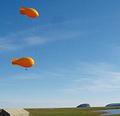 聯合國「2007-2008國際極地年」(International Polar Year)科學考察報告發現,全球暖化對極地造成的深遠影響已有新證據──兩極地區的冰雪量驟減不僅影響人類生活,更危及北極動植物生存、全球海洋與大氣環流,而海平面高度受影響將更為巨大。
聯合國「2007-2008國際極地年」(International Polar Year)科學考察報告發現,全球暖化對極地造成的深遠影響已有新證據──兩極地區的冰雪量驟減不僅影響人類生活,更危及北極動植物生存、全球海洋與大氣環流,而海平面高度受影響將更為巨大。
由於全球環境變遷近年來達到人類史上最劇,國際極地年科研對於許多地區上的污染物傳遞、物種演化、暴風形成與氣候變遷等更加了解。這些研究結果來自超過60個國家、共160個科學計畫。
在世界氣象學組織( WMO)與國際科學委員會(International Council for Science)合作下,國際極地年研究引領了北極與南極區的探測與了解,此項計畫由國際籌募12億美金的基金並歷時2年。研究顯示,格陵蘭與南極的冰帶正逐漸減少,造成海平面上升。而南極暖化擴張的速率比預期來得快,格陵蘭的融冰速率也在增加。
根據研究,2007至2008年,北極的年度最少海冰量也達到30年來衛星記錄的最低。國際極地年探勘隊也在北極記錄到空前的海冰飄移速率。因為全球暖化,北極區的植物種類改變,這將影響掠食類動物。
國際極地年研究另一項關於全球暖化的證據包含了證實南極海正變暖至全球均溫以上。南極洲附近的底層淡水量與南極洲融冰增加量相符,而這將影響洋流循環。這表示全球暖化正以超乎預想的方式影響南極洲。
國際極地年也發現,如同永久凍結帶中的甲烷,極地區也有貯存碳的大型水池。永久凍結帶融化的威脅會擾動儲存的溫室氣體並將之釋出至大氣中。研究觀察到西伯利亞海岸有大量甲烷逸自海底沉積物。
在生物多樣性研究方面,南極海的調查發現一個豐富多色的複雜生物區。在全球暖化下,有些物種正往極地區遷徙。
 國際極地年也提供大氣研究上的新觀點。研究發現北大西洋暴風是極地區的熱源以及蚊蟲的主要來源。了解此機制將增進對暴風路徑與強度的預測。
國際極地年也提供大氣研究上的新觀點。研究發現北大西洋暴風是極地區的熱源以及蚊蟲的主要來源。了解此機制將增進對暴風路徑與強度的預測。
臭氧洞研究上發現,南極洲上的臭氧濃度和南極海上的風與暴風形成條件之間新關係。這也將增進氣候與臭氧耗損的預測。
許多北極地帶的居民如當地社區民眾也參與此次國際極地年計畫。超過30個計畫關注在北極社會與人類科學的議題,包括食物安全、物染、健康問題等,透過研究將更能理解為何要如此強調這些緊迫挑戰的必要。
極地研究報告的檔案也提議未來行動的優先順序,以確保社會有足夠的資訊了解極地變化、其未來演變趨勢及對全球的衝擊。下次大型的國際極地年科學研討會將在2010年6月於挪威奧斯陸(Oslo)舉行。極地研究報告的檔案請點此進入相關網站。
New evidence of the far-reaching effects of global warming in the polar regions has emerged from the scientific explorations of International Polar Year 2007-2008. Snow and ice are declining in both polar regions, affecting human livelihoods as well as local plant and animal life in the Arctic, as well as global ocean and atmospheric circulation and sea level.
At a time in which the global environment is changing faster than ever in human history, IPY science has increased understanding of pollutant transport, species' evolution, and storm formation and climate change, among many other areas.
The IPY findings result from more than 160 endorsed science projects assembled from researchers in more than 60 countries.
A joint project of the World Meteorological Organization and the International Council for Science, IPY spearheaded efforts to better monitor and understand the Arctic and Antarctic regions, with international funding support of about US$ 1.2 billion over the two-year period.
It now appears clear that the Greenland and Antarctic ice sheets are losing mass, contributing to sea level rise. Warming in the Antarctic is much more widespread than it was thought prior to the IPY, and it now appears that the rate of ice loss from Greenland is increasing.
Researchers also found that in the Arctic, during the summers of 2007 and 2008, the minimum extent of year-round sea ice decreased to its lowest level since satellite records began 30 years ago. IPY expeditions recorded an unprecedented rate of sea-ice drift in the Arctic as well. Due to global warming, the types and extent of vegetation in the Arctic shifted, affecting grazing animals and hunting.
Other evidence for global warming comes from IPY research vessels that have confirmed warming in the Southern Ocean above the global average. A freshening of the bottom water near Antarctica is consistent with increased ice melt from Antarctica and could affect ocean circulation. Global warming is thus affecting Antarctica in ways not previously identified.
IPY research has also identified large pools of carbon stored as methane in permafrost. Thawing permafrost threatens to destabilize the stored greenhouse gas and send it into the atmosphere. IPY researchers along the Siberian coast observed substantial emissions of methane from ocean sediments.
In the area of biodiversity, surveys of the Southern Ocean have uncovered a rich, colorful and complex range of life. Some species appear to be migrating poleward in response to global warming.
IPY has also given atmospheric research new insight. Researchers have discovered that North Atlantic storms are major sources of heat and moisture for the polar regions. Understanding these mechanisms will improve forecasts of the path and intensity of storms.
Studies of the ozone hole have benefited from IPY research, with new connections identified between the ozone concentrations above Antarctica and wind and storm conditions over the Southern Ocean. This information will improve predictions of climate and ozone depletion.
Many Arctic residents, including indigenous communities, participated in IPY's projects. Over 30 of these projects addressed Arctic social and human science issues, including food security, pollution, and other health issues, and will bring new understanding to addressing these pressing challenges.
The "State of Polar Research" document also recommends priorities for future action to ensure that society is best informed about ongoing polar change and its likely future evolution and global impacts. A major IPY science conference will take place in Oslo in June 2010.


